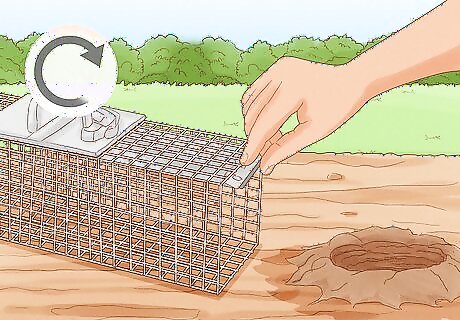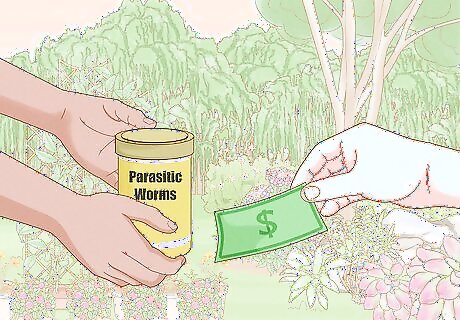
views
Setting up a Trap

Purchase a live trap. An animal trap is a hands-free way to humanely catch an armadillo and get it out of your hair for good. Purchase a large one-door animal trap from a store like Home Depot or Walmart. Make sure that the trap you purchase is a live trap, also known as a catch-and-release trap. These traps are non-lethal and won't harm the armadillo. Try to get a trap with measurements around 12” x 10” x 30”.

Observe the armadillo. Before setting up the trap, take note of where the armadillo likes to hang out in your yard. You may notice that it burrows in a specific hole or that it tends to hide in a certain corner. Understanding the armadillo's patterns will help you know where to set up your trap. Also check outdoor structures like your shed or garage.

Position the trap. Since armadillos usually come out at nighttime and in the early morning, set your trap up during the afternoon when the armadillo is out of sight. Place the trap in an area you have seen the armadillo crawl through. If the armadillo has a burrow, place the trap with the mouth of the trap near the hole. If the armadillo likes a certain area of underbrush, place the trap with the mouth facing the path the armadillo usually takes. In general, armadillos prefer to crawl along the outskirts of a space rather than through the middle. Avoid placing the trap in the middle of the room or yard unless you've seen the armadillo there often. Some people decide to bait armadillo traps with earthworms. However, it's best not to bait traps since armadillos naturally burrow and dig to get their food and rarely eat things they find on the ground. The bait also may attract raccoons or other unwanted animals. Consider setting boards in a V-shape leading into the trap to lure the armadillos inside.

Check regularly on the trap. Check on the trap several times a day after setting it. You don't want to trap the armadillo only to forget about it, causing the animal distress. If after a few days the armadillo is still loose, consider moving the trap to another location that the armadillo favors. If you have tried repositioning the trap and the armadillo still doesn't go in, call animal control.

Release the armadillo. After you have captured the armadillo, try to release it as soon as possible. Put on protective gloves to protect your hands from the armadillo's claws. Place the cage on floor of your car or in the bed of your truck. Drive at least five miles away from your home to a wooded area, preferably one around water, and open the cage to release the armadillo. Stand behind or to one side of the cage as you release the armadillo. There's no reason for it to attack you, but you should still try to not stand directly in front of its path.
Deterring Armadillos

Install a fence. A fence is the best way to prevent future armadillos from entering your house or backyard. Because armadillos tend to dig and burrow, make sure that the fence starts a foot below the ground. Through putting up a fence is a lot of work, so is repairing a damaged garden or backyard after an armadillo has dug it up. Though having just one armadillo may not warrant putting up a fence, if it is a recurring problem a fence may be your best option. The material of the fence doesn't matter as long as it's sturdy and is installed a foot into the ground.

Figure out their point of entry. If you have caught armadillos inside your house, try to figure out how they got in. Look for any holes or spaces in your house, particularly in seldom-visited places like your basement. Once you have pinpointed the way that the armadillos are getting in, consult a carpenter about the best way to seal your house from small animals. Likewise, if you already have a fence around your backyard and the armadillo is still getting in, try to see if the armadillo has dug a hole under your fence that it's using to get in. Fill in the hole with dirt, and if the problem persists, consider installing the fence a foot or more into the ground.

Close any burrows in your yard. Armadillos often dig burrows, or large holes, as they are scavenging for food in the ground. If an armadillo has left a burrow in your yard, fill it up with dirt. This will discourage other armadillos from continuing work on the burrow and further disrupting your lawn. Fill the burrow completely with pea gravel and dirt to make it less easy to dig up.

Remove brush and potential shelter. Armadillos tend to like dark, enclosed places like the space inside clumps of bushes or behind low-hanging brush. If you repeatedly notice armadillos in your yard, consider changing the landscaping to eliminate potential shelter. This could involve snipping overhanging branches or moving patio furniture toward the middle of the lawn to prevent armadillos from hiding under it.

Make your yard smell unpleasant. Armadillos have exceptionally strong senses of smell and are naturally repelled by certain scents. Castor oil is a substance proven to repel armadillos. It is usually marketed toward moles and gophers, but works on several foraging animals. Follow the instructions on the bottle for the best effect. The scent of mothballs also repels armadillos. Place mothballs around burrows as well as any areas you want to protect like your garden to stave off armadillos. Armadillos are also repelled by the scent of cayenne pepper. Shake cayenne pepper liberally around your yard to ward them off. You can also soak a rag in vinegar or ammonia and leave it near the burrow to repel armadillos.

Purchase parasitic worms. If you are having trouble with armadillos in your garden, spread parasitic worms in your garden or flower beds. Parasitic worms feed on many of the insects that armadillos eat. After the worms have stayed in your yard for a few days, armadillos will see that your yard is not a good food source and won't come back.




















Comments
0 comment